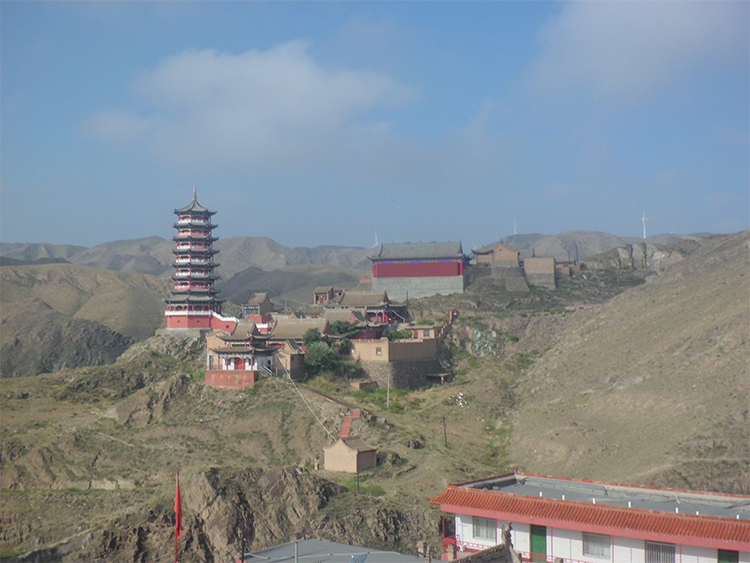Explore Niushou Mountain Temples: Ancient Buddhist Architecture with Yellow River Views
Introduction
On the banks of the Yellow River in Qingtongxia (Qingtongxia City), Ningxia, a steep peak rises like a giant ox lifting its head—Niushou Mountain. At its summit a temple complex more than 900 years old stands among pines and cypress: red walls and gilded roofs, Han-style eaves and Tibetan prayer flags whispering in the wind. This is Ningxia’s largest Buddhist complex and a rare place where history, faith and natural spectacle meet. Walk its paths and you’ll hear distant chants while the Yellow River flows below—time seems to still, leaving only quiet and reflection.
1. Niushou Mountain Temple Complex: Western Xia Legacy and Han-Tibetan Buddhist Treasure
One-line summary: Ningxia’s largest Han-Tibetan style temple complex, offering dramatic Yellow River views and continuous worship for centuries.
Niushou Mountain’s temple group was first built in the Western Xia period (1038–1227) and has a history exceeding 900 years. Repaired through the Ming and Qing dynasties, surviving structures such as the Daxiong Baodian (Great Hero Hall) and Dizang Hall are well preserved. The site was listed as a national key cultural relic protection unit in 2013. The temples follow the mountain’s ridgeline—Daxi Tian (Great Western Heaven), Xiaoxi Tian (Small Western Heaven), Qingliang Temple and more—scattered along cliffs and valleys. Viewed from a distance, the cluster seems suspended in the clouds, earning it the nickname “Ningxia’s Little Wutai.”
As a living testimony to the blend of Han and Tibetan Buddhism, the complex displays unique architectural fusion: Han-style bracketed eaves and Tibetan gilded roofs and prayer flags coexist harmoniously. Interior statues combine the solemnity typical of Han Chinese Buddha images with the mystery of Tibetan iconography, and murals and painted decoration show influences from both traditions. The complex functions both as an active pilgrimage site and a living museum for multi-ethnic religious culture.
2. Architecture and Art: Halls, Statues and Yellow River Light
(1) A Han-Tibetan architectural marvel
Most existing buildings date from the Ming and Qing periods, with the Daxiong Baodian at the core and a traditional central axis layout. Tibetan elements appear in details: gilded roof finials glint in sunlight, wind bells chime at roof corners, prayer wheels circle the exterior and worshippers walk clockwise in Tibetan custom. The Dizang Hall enshrines a compassionate Ksitigarbha (Dizang) statue, while the Ten Yama Kings murals vividly depict cause and effect in bright mineral pigments.
(2) Must-see art and viewpoints
– Daxiong Baodian Three Buddhas: The main hall houses Sakyamuni, Bhaisajyaguru (Medicine Buddha) and Amitabha—each statue reaches about five meters in height, crafted from gilded clay with flowing, lifelike robes.
– Ming dynasty murals: Some halls preserve Ming-era religious murals painted with mineral pigments; the lines are delicate and the colors astonishingly fresh even after centuries.
– Yellow River panorama: From the Daxi Tian viewing platform you can look down on the Yellow River winding like a golden ribbon at the mountain’s base—sunset here is especially dramatic.

3. Immersive Experiences: Morning Chants, Temple Fair and Pilgrimage Customs
Niushou Mountain remains an active religious site. Each morning monks chant and sound bells and drums that echo through the valleys. Visitors may observe morning prayers or participate in simple devotional acts:
– Incense etiquette: The temple provides eco-friendly incense. Hold two sticks at forehead level, silently state your wish, then place them in the censer. Avoid handling incense with dirty hands or after handling meat and strong-smelling foods.
– Lunar March 15 Temple Fair: Every year around the 15th day of the third lunar month thousands of pilgrims come to worship. The mountain path fills with stalls offering local snacks and traditional crafts, alongside religious ceremonies.
4. Practical Guide: Planning Your Visit and Avoiding Pitfalls
Basic information
– Address: Niushou Mountain, Qingtongxia City, Wuzhong, Ningxia Hui Autonomous Region
– Opening hours: 08:00–18:00 (winter until 17:00)
– Admission: CNY 60 (includes access to the whole temple complex)
Transportation tips
– Public transport: Take a long-distance bus from Yinchuan to Qingtongxia, then transfer to the local tourist shuttle to the mountain base.
– Driving: The site has a parking lot (CNY 10 per day).
Local advice
– Best times: Early morning (07:00–09:00) for quiet photography; late afternoon for Yellow River sunsets.
– Pitfall warnings: Ignore unofficial “donation boxes” or fortune-tellers outside official areas. Respect religious etiquette: no flash photography inside halls, keep noise to a minimum, and follow instructions from temple staff.

Conclusion
Niushou Mountain’s temple complex is a rare cultural gem—Western Xia history, Han-Tibetan artistic synthesis, the power of the Yellow River and Buddhist insight converge here. Whether you come for faith or architecture, this cloud-hung sanctuary delivers a timeless experience. Choose a clear day, climb Niushou Mountain, let the bell cleanse your mind and the river enter your dreams.


